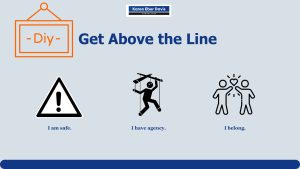
How Nonprofit Leader Navigate Crisis with Clarity & Confidence
I hope you never need this post.
Unfortunately, you will.
Every nonprofit leader faces challenges, some from external sources like disasters, financial markets, and shifting polities. Others come from within—board conflicts, staff burnout, or donor uncertainty.
During crisis times, it can feel impossible to move forward. But effective leadership isn’t about avoiding challenges: it’s about navigating them with resilience, clarity, and strategy.
How to Lead During a Crisis
I gathered four essential crisis leadership strategies to help you lead through tough times and emerge stronger. They offer a holistic, structured approach to what to do and why. They invite you to:
- Lead ready to learn.
- Take care of your team.
- Tap other people’s wisdom.
- Balance what is and what will be.
1. Shift Your Mindset: Lead from Above the Line
 Imagine a line. Above it, you’re open, curious, and ready to learn.
Imagine a line. Above it, you’re open, curious, and ready to learn.
Below it, you feel defensive, overwhelmed, and stuck.
In times of crisis, most leaders (and the people around them) default to below the line (think tigers and survival mode). Great leaders consciously move above the line, making strategic, clear-headed decisions. The strategic approach invites you to name where you are—above or below the line—and then choose to move above it before you respond.
Resource:
Locating Yourself – A Key to Conscious Leadership: Video, 4 minute
 Practical Questions to Reset Your Leadership Mindset
Practical Questions to Reset Your Leadership Mindset
While not part of the video, this information takes you to the next step: How do I get above the line? Important. Fears for safety, agency, and belonging drive people below the line. How can you get above the line?
Do a check-in with these questions:
- Am I safe? (Are there real “tigers”?)
- Where do I have agency? (What’s one small step I can take?)
- Where do I belong? (Who are my supporters?)
Example: A nonprofit CEO I coached felt boxed in. He had no agency. Together, we found one area where he could act. That single step shifted everything else. Within a day, momentum returned.
Use It Now: Ask yourself, “Am I leading from above or below the line?”
2. Support Your Nonprofit Team Through Crisis and Recovery
Research shows that 70 percent of people can grow through adversity but only with proper support.
How to Build a Resilient Team During a Crisis
• Set Boundaries: Separate crisis work from personal time. Elizabeth McNaughton suggests simple physical markers, like specific “work shoes,” that go out of sight at night.
• Form a Recovery Crew. Build a dedicated “recovery crew” for ongoing help.
• Normalize Rest and Reflection: Encourage reflection breaks even in urgent times. Keep burnout at bay.
The goal? Maintain a dual focus: one on immediate needs and the second on protecting your team’s long-term well-being and monitoring for burnout.
Example: One executive director I worked with struggled to “turn off” work stress. After adding a clear end-of-day cue, her team followed suit—reducing burnout in her team.
Resources:
- Supporting Employees Through Disaster Recovery: Video, 31 min
- 7 Practical Ways to Support Your Nonprofit Team Through Crisis and Beyond: Post, 3 minutes
Use It Now: Pick a small but clear habit to signal the end of your workday.
3. Leverage Insights from Crisis Leadership Experts
One of the best ways to navigate a crisis is to tap into the wisdom of leaders who’ve been there before.
To tap into the practical wisdom of over 100 disaster recovery leaders on the human side of recovery, check these New Zealand Red Cross resources. It’s not a booklet about how to distribute resources. Instead, it’s a reminder that you’re not alone and can draw on the courage and lessons of those who’ve been there—the focus on the human side of the crisis. There are patterns to learn.
Crisis recovery follows three predictable phases:
► Initial Heroic Energy
► Exhaustion
►Growth Potential
Resource:
Leading in Disaster Recovery: A Companion Through the Chaos: Booklet, 42 pages
Use It Now: Where are you right now? Identifying your stage can help you take the next best step.
4. Balance Reality & Resilience: The Stockdale Paradox
This Stockdale Paradox concept, named after Admiral Jim Stockdale, is about holding two truths:
►face the brutal facts of your current reality
►maintain unwavering hope that you’ll prevail.
You might be grappling with funding cuts, public pushback, or staff burnout. The Stockdale Paradox reminds us to face these challenges head-on while believing in long-term success.
Why it’s important? The optimist didn’t survive.
“You must never confuse faith that you will prevail in the end—which you can never afford to lose—with the discipline to confront the most brutal facts of your current reality, whatever they might be.” — Admiral James Stockdale
Resource:
Read how Admiral Stockdale learned this lesson: Post, 2 minutes
Use It Now:
Ask yourself: What are the brutal facts? Why do you know you will prevail?
Leadership Through Crisis: A Final Word
Crisis leadership is not about avoiding difficulties. It’s about navigating them with clarity and strategy.
Resources #1 and #4 help me frame tough times in a way that places solid ground under my feet and bolsters my determination. After watching #2, I shut the bedroom door at night and left the burdens outside. I love the richness of the lived experience of leaders who have made it to better times in #3.
I’m curious what you think. Which of these strategies resonates most with you? What has helped you lead through tough times?
For more information, download our free guide: How to Lead Your Organization to New Heights- In Just 15 Minutes a Day. It will serve you well and it works even in tough times.
Karen Eber Davis is a nonprofit strategic planning consultant who works with visionary leaders committed to taking their organizations to new heights. She offers customized strategies, assessments, and coaching designed to help leaders lead their organizations to achieve their potential. She is the author of 7 Nonprofit Income Streams and Let's Raise Nonprofit Millions Together.
Categories
If you appreciate these Added Value posts, please consider subscribing.
Latest Posts
- The Uncertainty Vortex: How Visionary Nonprofit Leaders Move Forward Without Clarity
- How New Nonprofit CEOs Secure Board Buy-In for Strategic Planning
- How Nonprofit Leader Navigate Crisis with Clarity & Confidence
- One Way AI Can Help You Find a Path Where None Exists
- In Crisis? Resist Cutting Your Ability to Make Income
